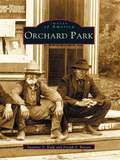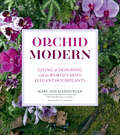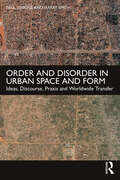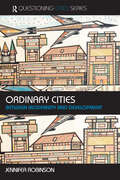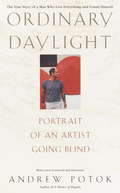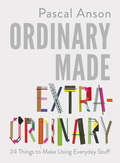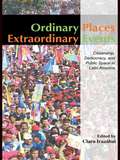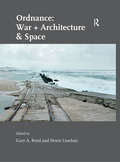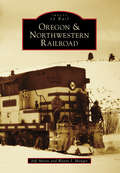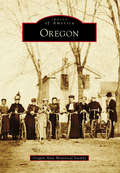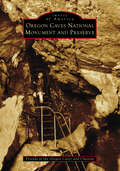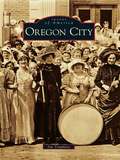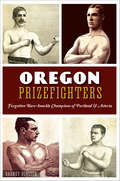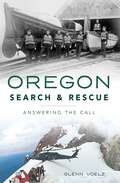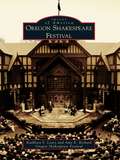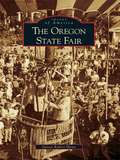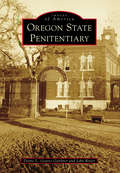- Table View
- List View
Orcas Island
by Orcas Island Historical Society and MuseumOrcas Island, the largest of the 172 islands in San Juan County, lies in the Salish Sea north of Puget Sound. Known as the "Gem of the San Juans" for her shimmering emerald hills bounded by 125 miles of rocky, tree-lined shore, Orcas was home to countless generations of Native Americans before the arrival of its first white settlers, formerly Hudson's Bay men who had hunted on the island, in the late 1850s. An international boundary dispute, popularly known as the Pig War, prevented early pioneers from settling land claims until the dispute was resolved by the German kaiser in 1872. Settlement grew slowly until improved steamship routes and increased commerce brought more tourists to the island. In 1906, Robert Moran built a fabulous estate, Rosario, now a world-class resort. Thousands of visitors have been coming to Orcas Island over the years to explore her forested hills, camp in Moran State Park or stay at one of the many historic resorts, and fish in the pristine waters surrounding this island paradise.
Orchard Park
by Joseph F. Bieron Suzanne S. KulpAttracted by the fertile soil, ample forests, and abundant water, the first pioneer arrived in the Orchard Park area in 1803, making this one of the earliest settlements in western New York. Prominent among the settlers were the Quakers, who built a picturesque meetinghouse that is still in use today. Orchard Park portrays the history of the community through its citizens and their homes and businesses, many of which were at Four Corners. Plank roads and then a railroad and finally a trolley provided opportunities for the community to share in the prosperity of nearby Buffalo in the late 1800s. Old family heritage persists in the names of streets on which century-old houses still stand, connecting yesterday with today.
Orchid Modern: Living and Designing with the World's Most Elegant Houseplants
by Marc Hachadourian“This beautiful book is useful for all of us, novice and experienced orchid lovers alike.” —Martha Stewart, author, entrepreneur, founder of Martha Stewart Living Omnimedia Add the vibrant colors and exotic blooms of orchids to your houseplant haven! It’s easier than you think with the help of Orchid Modern. Marc Hachadourian, the curator of the orchid collection at the New York Botanical Garden, shares his secrets to successfully growing these sometimes finicky houseplants. Besides the basics, you’ll learn his top 120 orchid picks for green and not-so-green thumbs. Ten inspirational, step-by-step projects, including terrariums, a wreath, and a kokedama, provide the confidence to make orchids a thriving, vivid part of your home’s signature style.
Order and Disorder in Urban Space and Form: Ideas, Discourse, Praxis and Worldwide Transfer
by Harry Smith Paul JenkinsThe global application of Enlightenment-derived concepts to create social order through urban form suggests that we believe we know how to create a (future) ordered environment. But these notions of order and disorder need interrogation, especially as the world rapidly urbanises. Not only have such approaches failed to produce more social order, but it has become clear that the imposition of these ideas in cities of the South cuts across alternative systems of social and cultural order and creates new disorder. Thus, if we are serious about forms of urban order, then it is time to rethink what we mean by order in the fi rst place. As this provocative and timely book shows, what we think of as urban order is partial and restricted, and what we perceive as disorder usually masks underlying orders of social nature. The book is intended for architects, urban designers, planners and urban scholars, as well as urban policymakers, managers and residents, to consider a different approach to emerging urban space and form, starting from an understanding of the cultural imaginaries and social constructs that underpin the production of most urban fabric and engaging with these concepts and organisational forms to improve urban life for the majority.
Ordering Colours in 18th and Early 19th Century Europe (International Archives of the History of Ideas Archives internationales d'histoire des idées #244)
by Friedrich Steinle Sarah Lowengard Tanja C. KleinwächterThis book describes the international effort to give order to colours and thus facilitate communication about it, two topics deemed essential to a modernising world that were also recognizably complex. Expert essays will enhance readers' understanding of the struggle to coordinate nature with art at a time when approaches to both were undergoing rapid change. Ordering Colours shows how such seemingly trivial concerns as identifying the basic colours and disseminating appropriate colour diagrams had to meet philosophical, scientific and professional needs across Europe. Contributors detail the many schemes for colour systematization and their real-world applications; questions of concern to both academic- and manufacturing-focused investigators throughout the long 18th century. They bring together original research and new thinking about landmark early modern studies to address important developments as well as neglected historical contributions of European arts, sciences, and economies. This collection is an important addition to the libraries of all who are interested in public culture and manufacturing developments in the early modern period and is aimed at historians of art, technology, philosophy and physics.
Ordinary Cities: Between Modernity and Development (Questioning Cities)
by Jennifer RobinsonWith the urbanization of the world's population proceeding apace and the equally rapid urbanization of poverty, urban theory has an urgent challenge to meet if it is to remain relevant to the majority of cities and their populations, many of which are outside the West. This groundbreaking book establishes a new framework for urban development. It makes the argument that all cities are best understood as ‘ordinary’, and crosses the longstanding divide in urban scholarship and urban policy between Western and other cities (especially those labelled ‘Third World’). It considers the two framing axes of urban modernity and development, and argues that if cities are to be imagined in equitable and creative ways, urban theory must overcome these axes with their Western bias and that resources must become at least as cosmopolitan as cities themselves. Tracking paths across previously separate literatures and debates, this innovative book - a postcolonial critique of urban studies - traces the outlines of a cosmopolitan approach to cities, drawing on evidence from Rio, Johannesburg, Lusaka and Kuala Lumpur. Key urban scholars and debates, from Simmel, Benjamin and the Chicago School to Global and World Cities theories are explored, together with anthropological and developmentalist accounts of poorer cities. Offering an alternative approach, Ordinary Cities skilfully brings together theories of urban development for students and researchers of urban studies, geography and development.
Ordinary Daylight
by Andrew PotokAndrew Potok is an intense, vigorous, sensual man--and a gifted painter. Then, passing forty, he rapidly begins to go blind from an inherited eye disease, retinitis pigmentosa. Depressed and angry, he rages at the losses that are eradicating his life as an artist, his sources of pleasure, his competence as a man. He hates himself for becoming blind. But as he will ultimately discover, and as this remarkable memoir recounts, it is not the end of the world. It is the beginning.Ordinary DaylightThis the story of Potok's remarkable odyssey out of despair. He attempts to come to terms with his condition: learning skills for the newly blind, dealing with freakish encounters with the medical establishment, going to London for a promised cure through a bizarre and painful "therapy" of bee stings. He wrestles with the anguish of knowing that his daughter has inherited the same disease that is stealing his own eyesight. And then, as he edges ever closer to complete blindness, there comes the day when he recognizes that the exhilaration he once found in the mix of paint and canvas, hand and eye, he has begun to find in words.By turns fierce, blunt, sexy, and uproariously funny, Andrew Potok's memoir of his journey is as shatteringly frank as it is triumphant.From the Trade Paperback edition.
Ordinary Daylight: A Portrait of an Artist Going Blind
by Andrew Potok<P>Andrew Potok is an intense, vigorous, sensual man--and a gifted painter. Then, passing forty, he rapidly begins to go blind from an inherited eye disease, retinitis pigmentosa. Depressed and angry, he rages at the losses that are eradicating his life as an artist, his sources of pleasure, his competence as a man. He hates himself for becoming blind. But as he will ultimately discover, and as this remarkable memoir recounts, it is not the end of the world. It is the beginning. <P> his the story of Potok's remarkable odyssey out of despair. He attempts to come to terms with his condition: learning skills for the newly blind, dealing with freakish encounters with the medical establishment, going to London for a promised cure through a bizarre and painful "therapy" of bee stings. He wrestles with the anguish of knowing that his daughter has inherited the same disease that is stealing his own eyesight. And then, as he edges ever closer to complete blindness, there comes the day when he recognizes that the exhilaration he once found in the mix of paint and canvas, hand and eye, he has begun to find in words. <P>By turns fierce, blunt, sexy, and uproariously funny, Andrew Potok's memoir of his journey is as shatteringly frank as it is triumphant.
Ordinary Made Extraordinary
by Pascal Anson'Filled with inexpensive and relatively easy do-it-yourself design projects for the home. Step-by-step photos show you how to do everything from dipping vintage cutlery in paint and reupholstering an armchair in shoelaces to covering a wall in mirrors' - Telegraph 'True original Pascal Anson urges us, with winning wit and idiot-proof step-by-steps to turn ''dad'' jeans, an ugly table, holey trainers, mismatched cutlery [...] into desirable stuff using the alchemy of imagination. His brief? Low skill levels and high concept' - World of Interiors In Ordinary Made Extraordinary designer, artist and maverick-maker Pascal Anson shows how easy it is to transform everyday items into extraordinary statement pieces. Make ordinary a thing of the past with 24 inspiring and achievable projects including: - Create a chandelier with just a few rolls of Sellotape. - Cast a stunning concrete plant pot. - Build a child’s treehouse with cling film.There are ideas for projects for everyone – from repairing and reinventing worn out trainers, to bigger projects such as the wood-clad car and the stylish hairy chair.
Ordinary Notes
by Christina SharpeA finalist for the National Book Award in NonfictionA finalist for the National Book Critics Circle Award in NonfictionNamed a Best Book of 2023 by The New York Times, NPR, New York magazine, Kirkus, and Barnes and NobleThe critically acclaimed author of In the Wake, “Christina Sharpe is a brilliant thinker who attends unflinchingly to the brutality of our current arrangements . . . and yet always finds a way to beauty and possibility” (Saidiya Hartman).A singular achievement, Ordinary Notes explores profound questions about loss and the shapes of Black life that emerge in the wake. In a series of 248 notes that gather meaning as we read them, Christina Sharpe skillfully weaves artifacts from the past—public ones alongside others that are poignantly personal—together with present realities and possible futures, intricately constructing an immersive portrait of everyday Black existence. The themes and tones that echo through these pages, sometimes about language, beauty, and memory, sometimes about history, art, photography, and literature, always attend, with exquisite care, to the ordinary-extraordinary dimensions of Black life.At the heart of Ordinary Notes is the indelible presence of the author’s mother, Ida Wright Sharpe. “I learned to see in my mother’s house,” writes Sharpe. “I learned how not to see in my mother’s house . . . My mother gifted me a love of beauty, a love of words.” Using these gifts and other ways of seeing, Sharpe steadily summons a chorus of voices and experiences to the page. She practices an aesthetic of “beauty as a method,” collects entries from a community of thinkers toward a “Dictionary of Untranslatable Blackness,” and rigorously examines sites of memory and memorial. And in the process, she forges a brilliant new literary form, as multivalent as the ways of Black being it traces.Color art throughout
Ordinary People: Extrodinary Lives
by Naguib KerbaEveryone has a story. A picture is worth a thousand words, but sometimes one needs words as well. ‘Ordinary people extraordinary lives,” does just that. I’ve combined a portrait with asking people four thought provoking questions about themselves. The portrait and their answers are a compelling read about life, its challenges and each individual’s journey. At the end of each chapter, each person makes one final observation learned from their journey.
Ordinary Places/Extraordinary Events: Citizenship, Democracy and Public Space in Latin America (Planning, History and Environment Series)
by Clara IrazábalClara Irazábal and her contributors explore the urban history of some of Latin America’s great cities through studies of their public spaces and what has taken place there. The avenues and plazas of Mexico City, Havana, Santo Domingo, Caracas, Bogotaì, SaÞo Paulo, Lima, Santiago, and Buenos Aires have been the backdrop for extraordinary, history-making events. While some argue that public spaces are a prerequisite for the expression, representation and reinforcement of democracy, they can equally be used in the pursuit of totalitarianism. Indeed, public spaces, in both the past and present, have been the site for the contestation by ordinary people of various stances on democracy and citizenship. By exploring the use and meaning of public spaces in Latin American cities, this book sheds light on contemporary definitions of citizenship and democracy in the Americas.
Ordnance: War + Architecture And Space
by Denis Linehan Gary A. BoydOrdnance: War + Architecture & Space investigates how strategies of warfare occupy and alter built and other landscapes. Ranging across the modern period from the eighteenth century to the present day, the book presents a series of case-studies which operate in and between a number of settings and scales, from the infrastructures of the battlefield to the logistics of the domestic realm. The book explores the patterns, forms and systems that articulate militarised spaces, excavates how these become re-circulated and reconfigured within other domains and discusses the often ephemeral legacies and residues of these architectures. The complexities of unpicking the spaces of the 'fog of war' are addressed by an inter-disciplinary approach which deploys graphic and textual analyses and techniques to provide new and unique perspectives on a hitherto underexplored aspect of architectural and spatial discourse: the tactics and programmes through which the built environment has historically been made to respond to the imperatives and threats of conflict and, in the context of the 'war on terror', continues to be so in ever more pervasive ways.
Oregon
by Eric A. Kimmel Dorothy Nafus MorrisonThe textbook contains many special features that will help you to read, understand, and remember the geography, history, and people of Oregon.
Oregon & Northwestern Railroad
by Jeff Moore Wayne I. MongerIn 1922, the US Forest Service offered one of the largest timber sales in the agency's history, encompassing 890 million board feet of mostly Ponderosa pine timber in the mountains north of Burns, Oregon. Among other requirements, the sale terms required the successful bidder to build and operate 80 miles of common carrier railroad through some of the most remote and undeveloped country in the state. The Fred Herrick Lumber Company and its Malheur Railroad initially won the bidding, only to lose it when a crash in the lumber market forced the company into insolvency. The Edward Hines Lumber Company of Chicago picked up the pieces, and from 1929 until 1984, its subsidiary Oregon & Northwestern Railroad made a living hauling logs, lumber, and occasional livestock between Burns and Seneca, Oregon.
Oregon (Images of America)
by The Oregon Area Historical SocietyOregon traces its beginnings back to 1841, when Bartley Runey built a log cabin just south of the village of Oregon along the �Old Lead Trail.� Primarily settled in the mid-1840s to 1850s, Oregon became a vibrant farming community. The railroad arrived in 1864 and provided a means of travel and transit, making Oregon the center of a much enlarged trade territory. By 1870, the population was 1,500, and many merchants, artisans, and tradesmen set up shop in the village to serve the needs of the community. Oregon was incorporated as a village in 1883. Following World War II, the coming age of the automobile with transportation and new highways and roads clearly marked Oregon�s change from an agricultural community to a suburban one. Today, Oregon is an active community with nationally recognized schools, parks, and sports and recreation programs. Oregon, Wisconsin, is home to two special landmarks: the official marker at Prairie Mound Cemetery for Nathaniel Ames, the area�s only Revolutionary War veteran, and the town�s World War I monument, believed to be the first World War I memorial in the United States.
Oregon Asylum
by Diane L. Goeres-GardnerThe Oregon State Insane Asylum was opened in Salem on October 23, 1883, and is one of the oldest continuously operated mental hospitals on the West Coast. In 1913, the name was changed to the Oregon State Hospital (OSH). The history of OSH parallels the development and growth in psychiatric knowledge throughout the United States. Oregon was active in the field of electroshock treatments, lobotomies, and eugenics. At one point, in 1959, there were more than 3,600 patients living on the campus. The Oscar-winning movie One Flew Over the Cuckoo's Nest was filmed inside the hospital in 1972. In 2008, the entire campus was added to the National Register of Historic Places, and the state began a $360-million restoration project to bring the hospital to modern standards. The story of OSH is one of intrigue, scandal, recovery, and hope.
Oregon Caves National Monument and Preserve (Images of America)
by Ms. Lucinda Harwood Ms. Susan DensmoreA stunning history of the development and preservation of the marble halls deep within the Siskiyou Mountains. In 2014 the designation of the Monument changed to the Oregon Caves National Monument and Preserve and the footprint was expanded to 4,554 total acres. The Friends of the Oregon Caves and Chateau have selected the best photographs to visually represent the colorful history of this iconic national treasure.
Oregon City
by Jim TompkinsIn 1829, Dr. John McLoughlin, chief factor of the Hudson's Bay Company Columbia Department, had two small cabins constructed on an island in Willamette Falls. The Kalapuya Indians promptly burned them, but a claim had been made and the roots planted for the oldest city in the Oregon Territory. Incorporated for over 160 years as Oregon City, McLoughlin's city at Willamette Falls has served as the political capital of an independent Oregon Country and the first capital of the Oregon Territory. Considered the oldest industrial site in the West, with saw, flour, paper, and woolen mills, Oregon City was also a transportation center for covered wagons, steamboats, and railroads. As a regional entertainment hub over the years, the community has provided both residents and visitors with such pleasures as Chautauquas, Oregon's first sporting events, the first state fair, a variety of annual festivals, and an array of opera, vaudeville, and movie houses.
Oregon Military (Images of America)
by Alisha Hamel Warren W. AneyOregon's military heritage goes back thousands of years, including native people's warrior traditions. Most of the cultures in this region were relatively peaceful, even welcoming visiting strangers, such as the Lewis and Clark overland Army expedition in 1805-1806. Then, overwhelming numbers of fur trappers, merchants, settlers, and miners began taking over traditional native grounds. From 1847 to 1880, native peoples experienced eight major conflicts with Army and volunteer forces. Army units built several forts from Oregon's coast to the Great Basin. Oregonians adopted militia laws, served in volunteer units, and organized the Oregon State Militia, which became the Oregon National Guard in 1887. The Guard benefited the state in many civil-support actions and served the nation in major overseas conflicts from the Spanish-American War to the current Operation Enduring Freedom.
Oregon Prizefighters: Forgotten Bare-knuckle Champions of Portland & Astoria (Sports)
by Barney BlalockIn 1884, London's prizefighting craze spread to Portland. Since the fights were illegal throughout the States, matches were fought in inconspicuous venues away from unwanted spectators. A winner could be hanged if the loser died. Champions like Dave Campbell, Jack "Nonpareil" Dempsey and "Mysterious" Billy Smith were just a few contenders for the brutal, nearly forgotten sport. Join author Barney Blalock as he reveals the remarkable stories of Oregon's bare-knuckle champions.
Oregon Search & Rescue: Answering the Call (Brief History)
by Glenn VoelzOregon's long tradition of volunteer search and rescue dates back to the territorial days, when Good Samaritans and mountain men came to aid those in need. On the coast, surfmen of the U.S. Life-Saving Service protected mariners traversing the "Graveyard of the Pacific." In the early twentieth century, outdoor clubs like the Mazamas, the Skyliners and the Obsidians served as informal search and rescue units, keeping Oregonians safe in the mountains, rivers and wilderness areas. After World War II, Oregon's volunteer teams began to professionalize and became some of the most effective units in the country. Join author Glenn Voelz as he recounts the history of Oregon search and rescue.
Oregon Shakespeare Festival
by Kathleen F. Leary Amy E. Richard Oregon Shakespeare FestivalIn 1935, Angus Bowmer, an instructor at Southern Oregon Normal School in Ashland, began with a dream and a small coterie of devoted friends who believed, as he did, in the value of Shakespeare performed on an Elizabethan stage. Though the Oregon Shakespeare Festival's early platforms were rudimentary and the backstage areas primitive, the art drew enthusiastic audiences. The urgency of World War II closed the festival's doors, but in 1947 it reopened with larger theater facilities and an expanded repertory, winning the support and respect of state, regional, and national artists and dignitaries. In a setting of extraordinary beauty and a community dedicated to culture and the arts, the 75-year-old Oregon Shakespeare Festival (OSF) is among the largest and most influential professional regional theaters in North America.
Oregon State Fair, The (Images of America)
by Steven Robert HeineSince the first Oregon State Fair was held on four acres along the Clackamas River in the Gladstone/Oregon City area in 1861, the fair has been the focal point of Oregon culture--a place to seeand be seen and to compete against the best in the state. It has been a place of victory and a place of discovery for nearly 150 years. For many generations of Oregonians, the fair was a chance for families and friends to reunite and share the excitement of this grand, uniquely Oregon event. Today the fair's popularity continues and, for 12 days each year, transforms the fairgrounds in Salem into the fifth largest city in the state.
Oregon State Penitentiary
by John Ritter Diane L. Goeres-GardnerAs the only maximum-security prison in the state, the Oregon State Penitentiary (OSP) has housed some of the most violent criminals on the West Coast, including brutal serial killers Charley Panzram in 1915 and Jerry Brudos in 1969. Sixty men have been executed inside OSP. The prison was originally built in Portland in 1851 but moved to Salem 15 years later, after Oregon became a state. From that time forward, the Oregon State Penitentiary grew from 23 prisoners in 1866 to 1,912 by 1992. The penitentiary suffered several serious fires and riots. On March 9, 1968, the most expensive riot ever experienced in the United States flared inside the walls, causing over $2.5 million in damages. Numerous escapes plagued the prison until 1970, when security measures were tightened. The most famous escape involved Harry Tracy and David Merrill in 1902.

